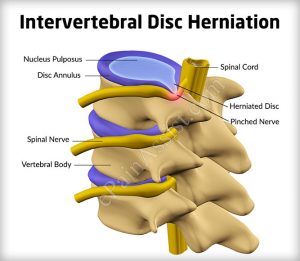In the vertebral column, an intervertebral disc (or intervertebral fibrocartilage) is located between adjacent vertebrae. Each disc has a fibrocartilaginous joint (a symphysis) that allows the vertebrae to move slightly, acts as a ligament to keep the vertebrae together, and acts as a shock absorber. An outer fibrous ring, the annulus fibrosus disci intervertebral, surrounds an inner gel-like base, the nucleus pulposus, in intervertebral discs. The annulus fibrosus is made up of many fibrocartilage layers (laminae).
Compressive forces may be absorbed by the stiff laminae. The nucleus pulposus, which is found in the fibrous intervertebral disc, helps to spread pressure uniformly around the disc. This prevents stress concentrations from forming, which could damage the underlying vertebrae or their endplates. Loose fibres suspended in a mucoprotein gel make up the nucleus pulposus. The nucleus of the disc serves as a shock absorber, absorbing the effect of the body’s activities while maintaining the separation of the two vertebrae. It’s a relic of the notochord.
Causes
68% percent of the first astronauts to fly in space complained of generalized back pain. Early in the flight, the pain is the most intense, and it lessens as the flight progresses.
Back pain in flight can be caused by a variety of factors, including:
1) The vertebral column lengthens due to reduced gravitational forces.
2) Weakness in the core and back muscles, as well as space-induced back muscle atrophy.
3) Proximal facet joint capsules are under further pressure.
4) Innervated vertebral endplates that have been fractured.
5) Degeneration of the discs.

